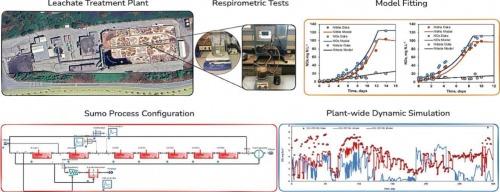揭示高温下渗滤液处理的生物过程动力学:全厂动态模拟和实验验证
IF 7.1
2区 环境科学与生态学
Q1 ENGINEERING, ENVIRONMENTAL
引用次数: 0
摘要
垃圾渗滤液的处理是一个重大的环境挑战,需要进行全面的评估。通过实验研究和全厂动态模型模拟,研究了高温对垃圾渗滤液处理厂生物过程动力学的影响。在25°C和35°C条件下,硝化菌的生长动力学根据生长速率(AOB为1.4和1.8天−1,NOB为0.8和0.9天−1)和衰变速率(AOB为0.2和0.3天−1,NOB为0.17和0.4天−1)分别进行了区分。在两种温度下观察到异养生长动力学相似,最大特定生长速率(2.2和2.5天−1)只有很小的变化。动态模型模拟表明,溶解氧(DO)和温度是控制AOB和NOB动态的两个主要因素,因此控制亚硝酸盐/硝酸盐反硝化途径。考虑到反应器中氨和亚硝酸盐的浓度很低,估计游离氨(FA)或游离亚硝酸盐(FNA)对硝化器的抑制现象是有限的。动态模拟还表明,在溶解氧(DO)有限的条件下,糖原积累生物(GAO)更容易生长,并在高温条件下胜过磷积累生物(PAO)。本文章由计算机程序翻译,如有差异,请以英文原文为准。

Unveiling the bioprocess kinetics of leachate treatment at elevated temperatures: plant-wide dynamic simulation and experimental validation
Treatment of landfill leachate (LL) poses a significant environmental challenge and requires a comprehensive evaluation. This study presents the impact of high temperature on bioprocess kinetics of a landfill leachate treatment plant (LLTP) via experimental investigation and plant-wide dynamic model simulation. The growth kinetics for nitrifiers were differentiated in terms of growth rates (1.4 and 1.8 day−1 for AOB, 0.8 and 0.9 day−1 for NOB) and decay rates (0.2 and 0.3 day−1 for AOB, 0.17 and 0.4 day−1 for NOB) for 25 °C and 35 °C, respectively. Heterotrophic growth kinetics were observed to be similar at both temperatures, with only minor variations in the maximum specific growth rates (2.2 and 2.5 day−1). Dynamic model simulations indicated that Dissolved Oxygen (DO) and temperature were the two major factors governing dynamics of AOB and NOB, consequently the nitrite/nitrate route for denitrification. The phenomenon of free ammonia (FA) or free nitrous acid (FNA) inhibition on nitrifiers estimated to be limited considering the very low level of ammonia and nitrite concentrations in the reactor. Dynamic simulations also showed that glycogen accumulating organisms (GAO) can easily grow when dissolved oxygen (DO) is limited and outcompete phosphorus accumulating organisms (PAO) at high temperature.
求助全文
通过发布文献求助,成功后即可免费获取论文全文。
去求助
来源期刊

Waste management
环境科学-工程:环境
CiteScore
15.60
自引率
6.20%
发文量
492
审稿时长
39 days
期刊介绍:
Waste Management is devoted to the presentation and discussion of information on solid wastes,it covers the entire lifecycle of solid. wastes.
Scope:
Addresses solid wastes in both industrialized and economically developing countries
Covers various types of solid wastes, including:
Municipal (e.g., residential, institutional, commercial, light industrial)
Agricultural
Special (e.g., C and D, healthcare, household hazardous wastes, sewage sludge)
 求助内容:
求助内容: 应助结果提醒方式:
应助结果提醒方式:


